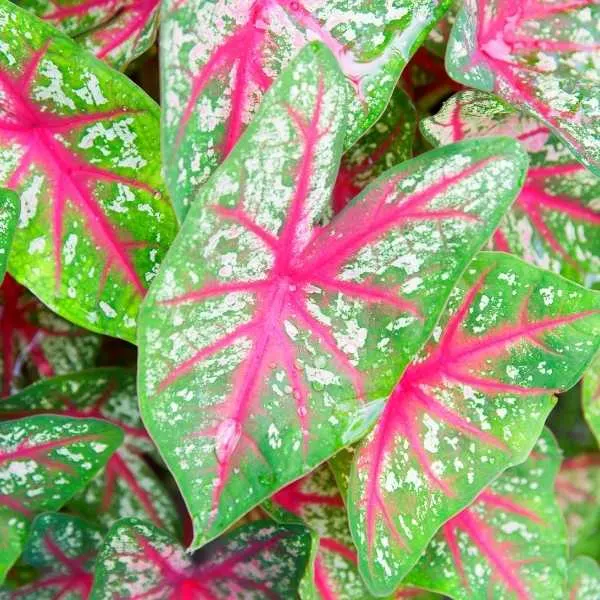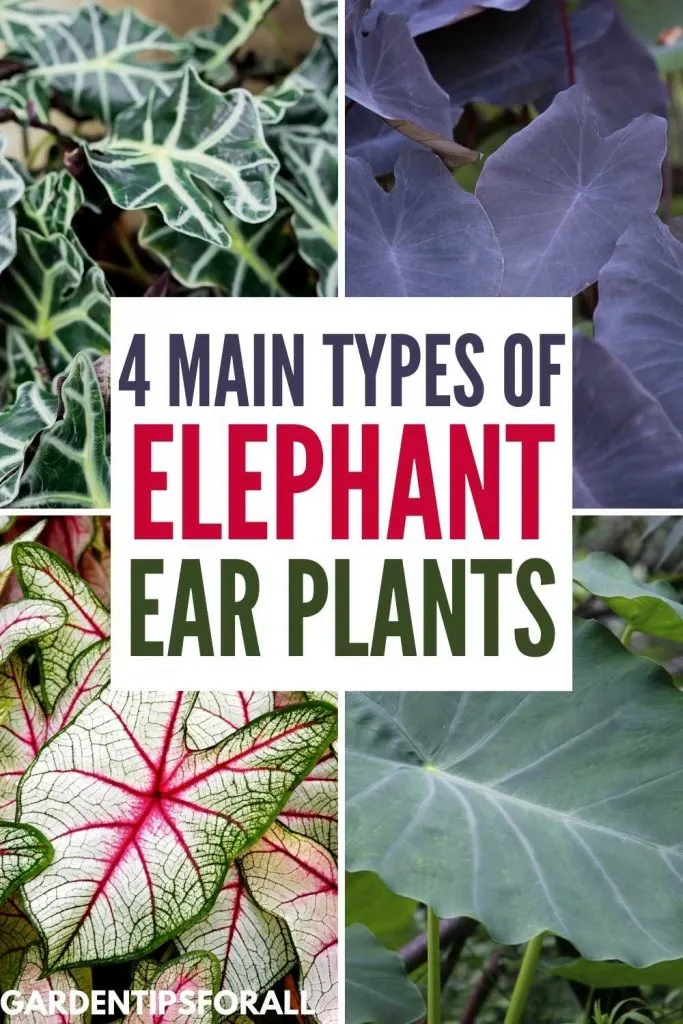The Main Elephant Ear Plant Types You Should Know About
Nothing like the elephant ear plants to give off a nice, tropical vibe! They will make a stunning addition to your garden, patio or indoor space. They grow to a pretty impressive height and make a striking sight with their enormous, heart-shaped leaves and lovely foliage.
Elephant ear plants are perennial, tropical plants that love the hot and humid weather. They thrive amazingly well in partial shade to the blazing sun in rich, moist soil. The best part is that they come in a range of species with a variety of colors and sizes.
There are 4 main types of elephant ear plants: Colocasia, Caladium, Alocasia, and Xanthosoma. Many of these elephant ears produce white spathe and spadix flowers. The height of these plants varies anywhere from puny 2-feet tall species to gigantic plants reaching up to 10 feet tall.

Elephant ear plants add beauty to any backyard, lawn or home space. They work great as flower bed backdrops, ornamental centerpieces in a room, border edges etc.
If you are looking to grow elephant ears at home and want to know more about the different varieties, you are at the right place. Let’s look more into an overview of the four main types of elephant ear plants.
Related Articles:
4 Common Elephant Ear Plants Varieties
Elephant ear plants are members of four tropical plant genera in the Araceae family. These aroid plants may differ in color and size, but they all share similar characteristics with their prominent heart-shaped or arrowhead leaves which grow from corms or tubers.
Below are the 4 common types of elephant ear plants.
#1. Alocasia

Alocasia is an evergreen perennial plant. It produces calla lily-like blossoms on 6-foot tall plants. But this type of elephant ear plant rarely blooms. It is grown abundantly for its huge, heart-shaped or arrow-shaped foliage with streaks in a variety of colors including black, bronze, and dark purple streaks.
There are 97 known alocasia plant varieties. When provided with the ideal conditions, alocasia plants will reward you by growing fast.
They grow well in bright, indirect sunlight and moist soil. Alocasia plants love bright, streaky light and humid conditions.
Alocasia plants grow between 2 and 6 feet with an equal spread. The striking aspect of these plants – the leaves – measure between 8 and 36 inches long, depending on the variety.
Their dark waxy leaves and lovely creamy-white prominent veins make people seek them out for their homes.
They make for beautiful accents and border edging. You can put them up in part shade or filtered sun and as such is suited for growing indoors in containers. If you are planting alocasia indoors, you need to plant them 30 to 60 inches apart in soil that is acidic, clay, sandy or loamy.
Winds and drafts will damage your plant, so you need to find a safe spot to safeguard it from heavy winds.
If they are outdoors, you will have to bring the plant indoors when winter sets. During the winter months, they require less water, so you should reduce the amount of water and maintain the temperature between 60 and 80 degrees Fahrenheit.
The leaves of the plants are toxic to pets and humans, so you should keep them away from your children and pets at home. They are inedible.
Here are 5 of the Most Popular Alocasia Species
- Alocasia Macrorrhizos Stingray
- Alocasia Odora or Night Scented Lily
- Alocasia Amazonica
- Alocasia Portora
- Alocasia Sanderiana
#2. Colocasia

Colocasia is one of my favorite elephant ear plants! They have big leaves shaped like a shield. They are the only species with peltate leaves. The leaves could grow up to 2 to 3 feet in length and 1 to 2 feet wide. Under the right conditions, the plants can reach heights ranging from 6 to 8 feet.
The interesting aspect about Colocasia plants is that they will display their leaves with the tip of the heart pointing downwards. The fleshy and robust leaves of Colocasia plants come in attractive red, lush green or purplish-black colors.
Colocasia is a plant native to swampy, tropical regions of southeastern Asia. You will be amazed to know that they span 200 species and have been cultivated for more than 6000 years.
The colocasia plants prefer full sun, provided you give them sufficient moisture and thrive well in indirect sunlight as well. They also require consistent moisture to grow well.
The Colocasia plants are wetland plants, so if you want to put them in pots around the edges of your pools and water surfaces, do so.
However, you should not plant them next to water sources outside of pots because they can grow and spread too rapidly. It might be difficult for you to contain their aggressive spread.
They make for fantastic landscape plants and are sure to bring a tropical feel to any garden.
Colocasia is otherwise called Taro plants. The Taro tubes are edible once cooked. In fact, they are a common food among people in Asia and South Pacific regions.
Here are 10 of the Most Popular Colocasia Varieties
- Hilo Beauty
- Lime Zinger
- Hawaiian Punch
- Black Magic
- Black Stem
- Diamond Head
- Colocasia Mojito
- Colocasia Tea Cup
- Colocasia Coffee cups
- Elena
#3. Caladium

Caladiums are perennial plants you will commonly come across in nurseries.
They are a rather smaller variety of elephant ear plants that can reach only 2 feet in height and have an equal spread. The foliage can grow up to 8 to 12 feet long, making Caladiums one of the amazing plants with big leaves.
The colorful leaves of Caladium can come in many combinations like red, pink, green, silvery-green, white, and cream. They are shaped in the form of a heart, and you can see prominent, vibrant-color veins on the leaves.
Watch out for the white flowers, which bloom in the summer months.
Caladium plants love the partial shade, but they can withstand full sun if taken care of in moist conditions. They grow well as container plants.
Caladium plants are sought-after for as edging or ground covers in shaded spots. You need to plant caladiums in clay, sandy, loamy, or acidic soil so that they can grow to their full potential.
Keep in mind to check the soil regularly for slugs, mealy bugs, snails, grasshoppers and caterpillars, though, these pests are not potential threats.
Here are 13 of the Most Popular Caladium Varieties
- Angel Wings
- Little Miss Muffet
- Caladium White Queen
- Candyland
- White Christmas
- Iceberg
- Caladium Bicolor
- Red Flash
- Pink Symphony
- Rose Glow
- Carolyn Whorton
- Postman Joyner
- Frieda Hemple
#4. Xanthosoma

Xanthosoma is native to tropical America. In the rain forests, they grow successfully under the canopy of the trees. Although not commonly cultivated, you can if you want to by adopting vegetative propagation.
If you are looking to cultivate them, you should know what conditions suit them best.
They do well in full sun and well-draining soil. Warm, humid conditions and temperatures over 60 degrees Fahrenheit are ideal conditions to grow them. These plants are typically grown for their roots and leaves and are edible when cooked.
There are around 75 species of Xanthosoma and they are noted for their characteristic pointed arrowhead-shaped leaves (sagittate). The leaves are a brilliant blue-green.
They grow beautifully in temperatures that are steadily over 68 degrees Fahrenheit. The arrow-shaped leaves are endowed with decorative veins. Like alocasia leaves, the leaves of Xanthosoma plants point upward or outward.
Here are 6 of the Most Popular Xanthosoma Varieties
- Lime Zinger
- Xanthosoma sagittifolium
- Xanthosoma Mouse cup Taro
- Xanthosoma Lindenii
- Xanthosoma Brasilienese
- Xanthosoma Violaceum
Final Thoughts on Types of Elephant Ear Plants
I bet you didn’t know there were so many varieties of elephant ears! There are actually hundreds. All of the cultivars can be categorized into one of the 4 types: Alocasia, Colocasia, Caladium and Xanthasome. Once you pick the type that works best for you, your garden and location, you can determine the species you want to grow.
Every one of these elephant ear plants is fairly easy to grow. If you provide them with the right conditions, they will reward you with their unique heart-shaped leaves, lush foliage and tropical vibes. Good luck!

